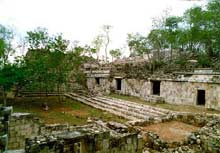Bonn archaeologists explore 1500-year-old Maya city

What the "Palace" building discovered by Teobert Maler looks like today. <br>AG Prem / Uni Bonn
Archaeologists of the University of Bonn have just begun the first of three series of excavation programmes in Xkipché on the Mexican peninsula of Yucatán. They are investigating the living conditions of the population shortly before the city was finally abandoned towards the end of the 10th century as well as the city?s role as the residence of local princes during the turbulent period of its decline.
The location of the find is in the vicinity of the world famous ruined city of Uxmal (recently accorded the status of world cultural heritage site), and like Uxmal goes back to the classical and late classical culture of the Mayas, being inhabited from ca. 500 to 1000 A.D. The focus of the current excavations is smaller buildings with a C-shaped ground plan, which are regarded as a reliable indicator of the last large-scale settlement of the Puuc region of Yucatán. A second focus of this research project, which is mainly funded by the German Research Association, is to investigate the living conditions of the less prosperous sections of the population. The Xkipché Archaeological Project is the first research project in the north of the Yucatán peninsula to specifically focus on the peasant class in the late classical period of the Maya culture, whereas almost all the other archaeological excavations in this region have been predominantly concerned with the role of the local and supra-regional élites.
German exploration of the ruined city of Xkipché is about a century old: between 1886 and 1893 the explorer Teobert Maler visited approximately a hundred large and small ruined sites in the Puuc zone of the Yucatán peninsula, which he recorded in descriptions, drawings and photographs. A large number of these ruins were subsequently lost in the dense scrub of this impassable hilly terrain and was only rediscovered in the last few decades. Xkipché was one of these, which Professor Hanns J. Priem of the Institute of Ancient American Culture and Ethnology (IAE) was able to reach in 1989 after a great deal of effort. From 1991 to 1997 archaeologists of the University of Bonn excavated a palace complex there, which with its two storeys and over 40 rooms, some of which were still well preserved, was one of the biggest in the entire region.
At around 1000 A.D. leadership was taken over by a different section of the population, whose buildings can be distinguished, among other things, by their poor workmanship. Finally the region was abandoned for almost a millennium. As yet it is only possible to speculate as to the reasons for this. Possibly excessive strain on the natural resources by the traditional method of slash-and-burn cultivation may have been a factor, which presumably coincided with an extensive period of successive years of low rainfall. This had catastrophic effects on an area without expanses of surface water, where the population was dependent on storing water from the rainy season for their water supply in the dry season. However, research findings show that social upheavals as a consequence of local wars and social unrest also seem to be increasingly probable factors.
The Xkipché project is being carried out at the invitation of the Mexican government by the IAE, a university institute which is specialised in research into the ancient cultures of America. The excavation is envisaged as being purely for research purposes, with subsequent access to the site for visitors not being intended.
Media Contact
All latest news from the category: Interdisciplinary Research
News and developments from the field of interdisciplinary research.
Among other topics, you can find stimulating reports and articles related to microsystems, emotions research, futures research and stratospheric research.
Newest articles

A ‘language’ for ML models to predict nanopore properties
A large number of 2D materials like graphene can have nanopores – small holes formed by missing atoms through which foreign substances can pass. The properties of these nanopores dictate many…

Clinically validated, wearable ultrasound patch
… for continuous blood pressure monitoring. A team of researchers at the University of California San Diego has developed a new and improved wearable ultrasound patch for continuous and noninvasive…

A new puzzle piece for string theory research
Dr. Ksenia Fedosova from the Cluster of Excellence Mathematics Münster, along with an international research team, has proven a conjecture in string theory that physicists had proposed regarding certain equations….



